Blog Archives
August 21, 2003 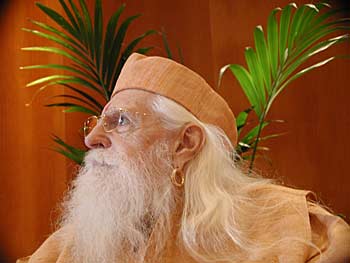
"To give up one's own personal desires is the first desire to perpetuate. Then to help others to fulfill their highest aspirations is the next challenge. Then to seek for ultimate attainment and fulfill that lingering desire takes a tremendous will. Then to lay a foundation for the betterment of peoples everywhere, in spreading the Sanatana Dharma to those open and ready to receive it and make it available to those who are not, is the ultimate challenge. "
Gurudeva
Our Beloved and Revered Satguru Sivaya Subramuniyaswami
Attained Maha Samadhi on November 12th, 2001
Click to read for Details.
We are pleased to announce the web release of Satguru Sivaya Subramuniyaswami's monumental work on Hindu culture and lifestyle:
Living with Siva.
Click here for the entire text and artwork, now on-line!
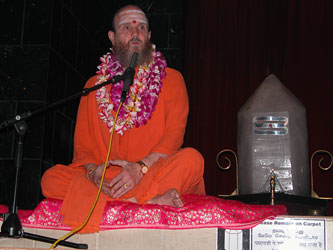
Bodhinatha gave his talk on the Yama of Brahmacharya today after the Sun One homa. Tomorrow he leaves for his three week trip. For details see his travel page which has been updated with a full schedule. (opens in new window)
Bodhinatha's Sun One Video. Most Recent update: July 30, 2003.
Bodhinatha speaks on Japa, Mantra Repetition, niyama # 9, elucidating the many dimensions of the sacred science of mantrams, chanting a holy syllable, word or sentence again and again.Japa may be done silently or aloud. Sometimes it is best to begin aloud, so the mind is more focused, then slowly let it become internalized as concentration improves. Often japa is done right after attending a puja. Japa is not used to acquire worldly things. Instead, prayers are used for that. People who anger should not practice japa.
The simplest japa is A-U-M. This is the primary sound of the universe. Initiation is important before starting the practice of japa yoga. Once initiated it is essential to continue the practice, to strive consistently and to chant as instructed by the guru.
14 minutes, 2 secondsNo Audio Today
|
Be surprised! Take this opportunity for an adventure. Close your eyes and click to get a message picked at random from the vast audio archives of our Satgurus' discourses |
And click here for an Index to All Past CyberTalks.
|
 |
|
|
|
Live Web Cam Pix! |
 |
||||
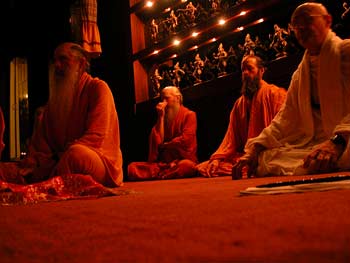
The precious hour before dawn holds a most significant place in Hindu culture. This is the most powerful time of worship, meditation and sadhana for Hindus since time immemorial.

With the chanting of Sri Rudram filling the temple, the fire is raised up.
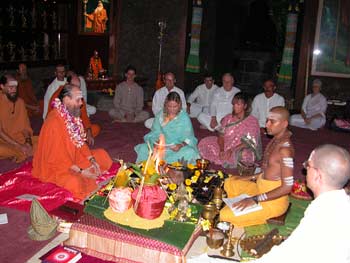
It was an especially auspicious day as Chudika Mahadevan took her brahmacharya vrata before the sacred fire.
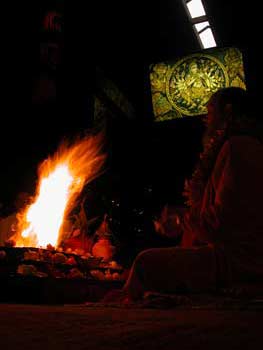
She spoke aloud, twice, before the fire and all the devotees:
"I, Chudika Mahadevan, seek the blessings of God, Gods and guru as I declare of my own volition my firm intention to live a pure and virtuous life and now take this brahmachariya vrata.
"I vow to value and protect purity in thought, word and deed, and chastity in body, to sublimate and transmute the sexual energies and the instinctive impulses of anger, jealousy, greed, hatred and selfishness.
"I promise to remain chaste and pure until marriage and wear this sacred brahmachariya cord around my waist to betoken this solemn oath."
For a complete course on brahmacharya, click here to see the online book called "Saivite Virtue." (opens in new window)
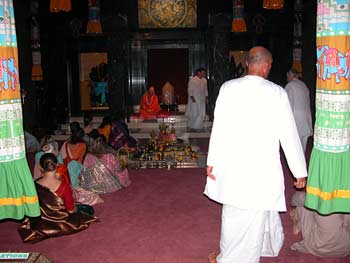
All the devotees come forward for sacred ashes after Bodhinatha's talk.
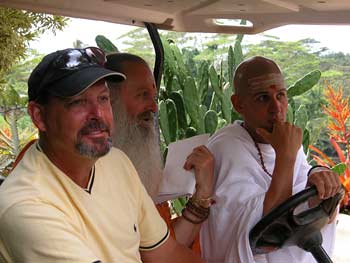
Here is our father, Mr. Chuck Baumann, whose son is Sadhaka Tejadeva. Sadhaka Tejadeva and Paramacharya Palaniswami take him for a tour of the monastery. Mr. Baumann was amazed at the site of the Iraivan Temple and very pleased to know that his son has dedicated his life to such a noble calling in being a monastic of our order.
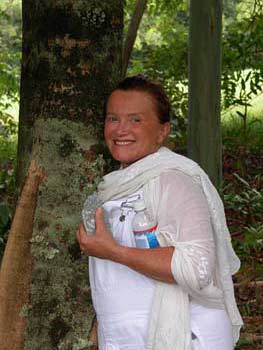
This is Mrs. Tara Guber, wife of well known Hollywood executive and producer Peter Guber. She hugs a Rudraksha tree during her tour. The Gubers have a residence on Kauai and Tara brought some of her friends today to worship in the temple and tour the property. Tara is doing really fantastic work with a program she has started called "Yoga Ed" in which she has dedicated her life to bringing yoga into the mainstream education curriculums of public schools.
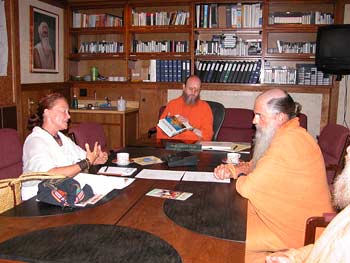
She has made a great success of this program among disadvantaged children in Los Angeles. With a practical and streetwise background as an elementary school teacher from Brooklyn, New York, she brings a high-minded vision and passionate selfless energy to her work. Tara has a proven success record and is now focusing on recruiting teachers to join her in the work. Here Sannyasin Natarajnathaswami interviews her for a future article in Hinduism Today. She articulated her mission to bring spirituality to the next generation. You can visit her web site at http://www.yogaed.com And, if you are a teacher in a public school with a mind to bring dharma in the heart of the mainstream American educational system... contact her today!
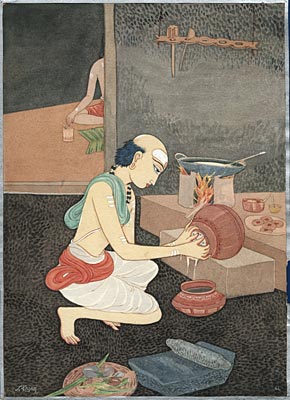
A touching scene from one of S. Rajam's paintings that will appear in Dancing with Siva.
 The Remarkable Vision |
Iraivan Temple Progress Update |
Join this historic undertaking. Please contribute generously. Sponsor a stone today! |
| Order Rudraksha Malas from Siva's sacred Hawaiian groves; and also single rudraksha beads ready to put on a chain around your neck. Great for Gifts! All proceeds go to the building fund. | ||
|
Current Overview  |
||
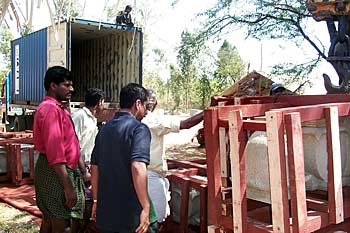
We are happy to announce that the 5th container has been sponsored with the help of several more generous donations. We want to work to sponsor three more, bringing the total of the next shipments to 8 containers. This will provide all the necessary stones for the continuing construction of the Iraivan Temple through the year 2004!.
![]()
Saiva Siddhanta Church Of Mauritius
Spiritual Park and Monastery
in the island country of Mauritius
in the Indian Ocean near South Africa
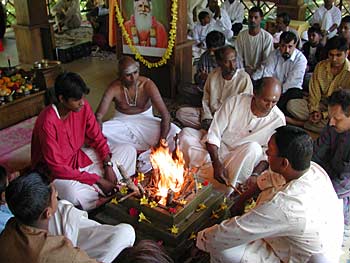
The Ganesha Homa is now turning into a very special event in Mauritius that devotees do not want to miss for any reason. For this month of August the Kulapatis of Flacq Valaytan, Kulagan and Mougam had the responsibilities to sponsor that spiritual event.
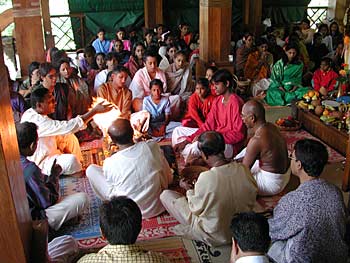
As usual, devotees would come from every part of the island and long rows of cars will be seen along the road adjacent the Spiritual Park.
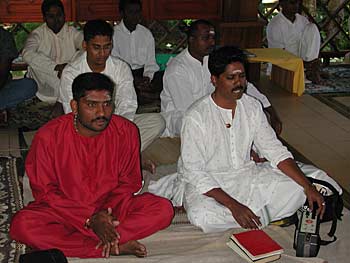
Adisankara, a student of the Himalayan Academy(on the right), is singing karnatic songs. Seated near him on the left in red kurta outfits is Church member Selvaraj Sanjeevee, a regular karma yogi at the Spiritual Park.
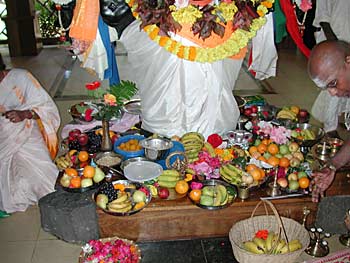
Everyone loves the mighty Ganesha who lovingly bestows Blessings to the devotees. Everyone loves bringing sweet offerings for Him that are placed at His Feet.
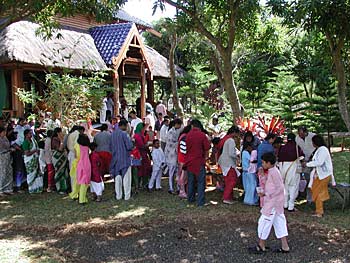
This is the prasadam serving time in the shade of the mango grove, a quiet and soothing place of natural beauty.
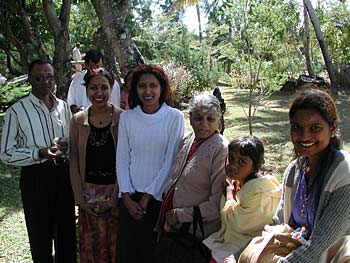
Here is a new family to the Park. Their faces translate their happiness to be at the Park.
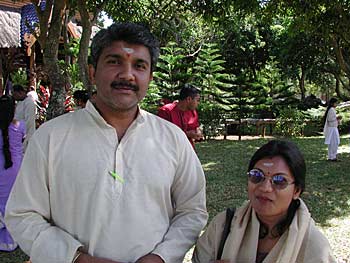
Kulapati Parmesh Pallanee and Kulamata Oumavadi, both looking happy and bright. Parmesh gave a wonderful testimony on that day on Lord Ganesha and encouraged everyone to read Gurudeva's book Loving Ganesha.
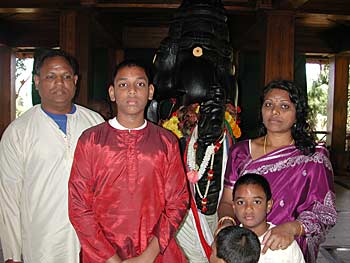
This is a wonderful family from the south. Ravind Doorghiat is a long time sishya of Gurudeva and is always happy to do seva at the Spiritual Park.
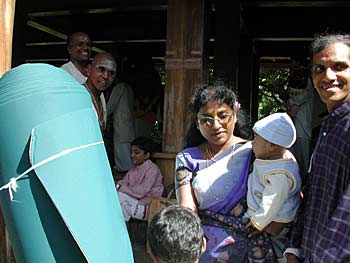
Devotees always look forward to support the Spiritual Park. Mr. Siven Rungen from Mahebourg in the south who is closely related to Brahmachari Vel Mahalingum donated a beautiful roll of blue soft carpet to be served as mats inside the Ganesha Mandapam. He noticed that the ceramic floor was too cold, especially in winter and wanted the devotees to be more comfortably seated. The Spiritual Park kindly thanks Mr. Rungen and his family for this generous donation.

Kulapati Siven Koothan (on the left) and Kiran Kirodhar, two generations apart, yet no one is really feeling that difference! This is the magic of this Park. Whatever be your age, you are always happy there!
| FULL INDEX OF 650+ CYBERTALKS
 |
|
Study Gurudeva's teachings.
|
transcription begins
Date: June_10_2003
Title: Yama #6 - Dhriti, Steadfastness
Category: Yamas and Niyamas
Duration: 15 min., 30 seconds
Date Given: April 18, 2003
Given by: Bodhinatha
Back to our Yamas. Working on the Yamas, as you remember we did Patience, last time. A couple of weeks ago? More than a couple of weeks ago, we had Sadhu Paksha. Couple of months ago, we did Yama #5. So today, we are up to Yama #6 - Steadfastness, Dhriti.
The #6 Yama is - Dhriti, Steadfastness, overcoming non-perseverance, fear, indecision and changeableness. Gurudeva begins his 'Living with Siva' lesson by stressing that the success of steadfastness depends on willpower.
"To be steadfast you have to use your willpower. Willpower is developed easily in a person who has an adequate memory and good reasoning faculties. To be steadfast as we go through life, we must have a purpose, a plan, persistence and push. Then nothing is impossible within the circumference of our prarabdha karma. Observe those who are steadfast. You will learn from them. Observe those who are not, and they, too, will teach you. They will teach what you should not do. To be indecisive and changeable is not how we should be on the path to enlightenment, nor to be successful in any other pursuit. Non-perseverance and fear must be overcome and much effort is required to accomplish this."
The Tirukural has a chapter on this subject, entitled 'Perseverance', Chapter 62. Verse 612, gives a useful perspective on the importance of Perseverance.
"Beware of leaving any work undone, remembering that the world abandons those who abandon their work unfinished."
The Tirukural chapter states that perseverance creates prosperity, the ability to overcome misfortune and to be generous and charitable. It also states that the lack of perseverance brings shame, abandonment and misfortune.
One of Gurudeva's own Mahavakyam applies here as well. "Consistency is the key to the conquest of karma."
All of the Yamas are for the purpose of harnessing tendencies of our instinctive nature. The common example given is driving a wagon pulled by a team of horses. Without reins the driver would lose control, the horses would run wild and eventually the wagon would overturn. The reins that control the horses are like the Yamas that control the instinctive mind. We, the driver, can successfully control the instinctive mind through always utilizing the Yamas.
In the case of steadfastness, the instinctive quality we are harnessing is the tendency not to stick to what we start. We are consistently creating a new plan, working at it for a short while and then abandoning it and creating a new plan again.
Here is an example. We suffer from chronic back pain. We go to a physiotherapist and he gives us some exercise to do. We do them for one month and then stop. A few months later, we go to an Ayurvedic Doctor for the same back pain and he suggests some herbs. We manage to take these for two months before stopping. Six months later, we go to another physician and he suggests a still different remedy. You get the idea! Of course, the man still has the back pain. No progress has been made due to lack of steadfastness.
This happens in Hinduism as well. We visit one swami and he suggests we chant a mantra. We do this for a few months and stop. We visit another swami, a year later and he suggests meditating on the inner light. We do this for a while and stop. This, of course, produces no tangible progress in our spiritual life due to lack of perseverance.
Let us look now at some of the reasons for non-perseverance.
A common reason for not preserving with an undertaking is that the original decision was an emotional whim rather than a well-thought-through plan.
Here is an example. We have lunch with a colleague at work who shares with us how he purchased a second home and is renting it out and earning excellent extra income, enough to take his family on pilgrimage to India last month. You think this idea is great. Wouldn't it be wonderful to be able to take your family on pilgrimage to India as well! You immediately purchase a second home and rent it out. After a year, you realize the price you paid was too high and you are earning less than the cost of the home. The enterprise is actually lowering your savings for the pilgrimage rather than increasing it. Therefore, you have to sell the house and incur a loss.
What went wrong? The initial decision was flawed. It was based on a passing emotion rather than a well-conceived plan. This problem can be avoided by taking time to make decisions, carefully gather all the facts. Talk in person to others who are successful at the enterprise. Share all this information with family and friends. Pray to Lord Ganesha for guidance. Put all this information in a detailed plan and ask for your preceptor's blessings on the plan.
There is also a sutra from Gurudeva that is quite related. "Siva's devotees approach each enterprise with deliberate thoughtfulness and act only after careful consideration. They succeed in every undertaking by having a clear purpose, a wise plan, persistence and push."
The ideas of deliberate thoughtfulness and careful consideration are just what we have been looking at. What the sutra adds is that we need, first of all, a clear purpose. What is our goal is pursuing this endeavor? Why are we thinking about doing this?
Sometimes we embark on an endeavor without a clear purpose. For example, our best friend starts to study Bharatanatyam, so we start as well. After five months, we conclude that this is too much work and give it up. Our reason for pursuing it was not solid enough, the fact that our best friend took it up. To stick to an undertaking, we need for it to be meaningful to our life, not to someone else's.
An essential part of steadfastness is overcoming changeableness. Changeableness means indecision, not be decisive. How can we discriminate between this and the strength of a person who changes his or her mind in wisdom because of changes of circumstances?
The person who is changeable, is fickle and unsure of himself, changing without purpose or reason.
Dhriti, Steadfastness describes the mind that is willing to change for mature reasons based on new information, that holds steadily to its determination, through thick and thin in the absence of such good reasons. Its decisions are based on wise discrimination. Having made a solid decision in the first place, only reconsider it in light of new information.
It is impossible to be steadfast if we are not obeying the other restraints that the Rishis of the Himalayas laid down for us as the fruits of their wisdom. All of these restrains build character. Dhriti, Steadfastness rests on the foundation of good character.
Gurudeva defines character as the ability to act with care. This is built slowly, over time with the help of relatives, preceptors and good-hearted friends. To be steadfast, you have to use your willpower. Willpower is developed easily in a person who has an adequate memory and good reasoning faculties.
Nandinatha Sutra 10 tells us, "Siva's devotees by remaining steadfast on the path, upholding the yamas and niyamas and relying on their indomitable will, move the forces of the world and are not moved or affected by them."
What does Gurudeva mean by an indomitable will?
Willpower is the channeling of all energies toward one given point for a given length of time. This can be brought out from the within, in everything that we do through the day. It is channelling the rarified energies of the body, of awareness itself, into attention and concentration upon everything that we do through the day.
How can this be cultivated? Gurudeva gives us two keys in 'Merging with Siva', to cultivating willpower.
"It can be cultivated by finishing and doing well, every task that we undertake."
That is both keys in one sentence.
It can be cultivated by finishing and doing well every task that we undertake. In fact, done a little better than our expectations.
First, finish each task. Second, do it well.
Nothing is done with half our mind thinking about something else. Nothing is dropped in the middle. Developing these two important habits produces an indomitable willpower.
Another reason for lacking steadfastness, is that even though we have a purpose, a clear goal, the goal is not realistic. We have set it too high. Therefore, we do not achieve it in a reasonable amount of time and give up.
Here is an example. A sincere seeker sets the goal of realizing the Self in three years. Go for it! First year, practicing Charya. Second year, focusing on Kriya. Third year, mastering Yoga. At the end of the third year, he will become a Jnani through Self Realization.
This, of course, is not realistic. Such an approach can cause the seeker to give up the spiritual path all together. Therefore, be sure to be realistic in the goals you set. Be sure to ask others knowledgeable in that field, if your goal is realistic before you finalize the goal.
Encountering obstacles is still another reason some choose not to persevere. There is a false concept held by some that, "If my endeavor encounters an obstacle, then Lord Ganesha is telling me what I am pursuing is not the right course of action. I should stop trying and rethink the entire project."
Gurudeva's teaching is that the more ambitious a project is, the more obstacles will be encountered. Therefore, if your goal is a grand one, before you even start, anticipate encountering significant obstacles. When you do, it is not discouraging.
"Preserving firmness of mind during periods of gain or loss of relatives" is the way Dhriti is described in the Sandilya Upanishad. This implies that during times of sorrow, difficult karmas, loss and temptation, when in mental pain and anguish, feeling alone and neglected, we can persevere, be decisive and bring forth the dhriti strength within us and thus prevail.
One translator of the Varuha Upanishad used the word, courage, to translate dhriti. "Courageous and fearless people who are just and honest prevail over all karmas, benevolent, terrible and confused."
This virtue is much like the monk's vow of humility, part of which is enduring hardship with equanimity, ease of mind, which means not panicking.
The Tirukural reminds us, "It is the nature of asceticism to patiently endure hardship and to not harm living creatures."
In fact, Gurudeva describes dhriti as a hard ship. Ready for this? "A ship that can endure and persevere on its course even when tossed about on the waves of a turbulent sea." A hard ship, that is a good one!
Some might wonder why it is good to passively endure hardship. To persevere through hardship one must understand, as all Hindus do, that any hardship coming to us we ourselves participated in setting into motion in the past. To endure hardship and rise above it in consciousness is to overcome that karma forever. To resent hardship, to fight it, is to have it return later at a most inconvenient time.
A person who is patient and truthful, who would not harm others by thought, word or deed and who is compassionate and honest has the strong nature of one who is firm in dhriti, steadfastness. He is the prevailer over obstacles. One firm in dhriti can be leaned upon by others, depended upon. He is charitable, has faith in God, Gods, and Guru, worships daily and manifests in his life a spiritual will and intellect. In relaxed moments, he experiences santosha, contentment, not being preoccupied by feelings of responsibility, duties or things left undone.
The spiritual path is a long, enduring process. It does not reach fruition in a year or even two years. The spiritual path brings lots of ups and downs, and the greatest challenges will come to the greatest souls. With this in mind, it becomes clear that steadfastness and perseverance are absolutely essential on the spiritual path to be successful.
In conclusion, foster steadfastness, overcoming non-perseverance, fear, indecision and changeableness. Achieve your goals with a prayer, purpose, plan, persistence, and push. Be firm in your decisions. Avoid sloth and procrastination. Develop willpower, courage and industriousness, overcome obstacles. Never carp or complain. Do not let opposition or fear of failure result in changing strategies.
Aum Namah Sivaya.
transcription ends
|
MORE UPLIFTING THINGS |
2004 Indian Odyssey
Join Satguru Bodhinatha Veylanswami on an 18 day Innersearch to South India, from Jan 19 to Feb 5, as we pilgrimage to ancient monasteries, magnificent 1,000 plus year old sacred temples and meet with India's holy men in a life-transforming adventure. Click on the above link for more details. |
|

|
Check our children and youth section for new items for the young and young at heart! | |
|
1. SIGN OUR GUESTBOOK and receive a FREE GIFT |
||
| 2. Newest Book: LIVING WITH SIVA | ||
|
3. Visiting KAUAI'S HINDU MONASTERY |
||
|
4. Contribute to THANK YOU, GURUDEVA FUND |
||